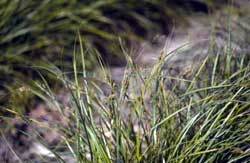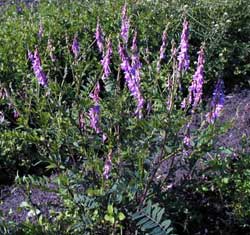| Chapter 5: Cultivars and Species for Use in Alaska Released for Commercial Seed Production Reedgrass, Nootka Pioneer Peak Germplasm nootka reedgrass was released in 2008. This was a Selected Class release with the "Natural" designation, indicating there was no intentional manipulation of the genetic base for specific traits. This accession was originally collected in 2000 near the Eklutna Flats. The primary use of this collection will be revegetation through interior and southcentral Alaska. 
Figure 117: Pioneer Peak Germplasm nootka reedgrass
Sedge, Longawn Attu Germplasm longawn sedge is a 2007 release by the Alaska Plant Materials Center (Wright, 2007). This sedge is quite common along coastal areas of Alaska. Its use in revegetation is suggested if coastal wetlands are impacted. 
Figure 98: Attu Germplasm longawn sedge
Speargrass, Largeflower Largeflower speargrass grows in coastal areas, most often behind foredunes or where foredunes do not exist. As an aggressive species that spreads vegetatively by rhizomes, it develops into large stands in coastal wetland situations. This accession was originally collected near the Port Clarence LORAN Station northwest of Nome, Alaska. This species is intended to be used on revegetation projects throughout coastal Alaska. Port Clarence germplasm was released in 2007 (Wright, 2007). 
Figure 109: Port Clarence Germplasm largeflower speargrass
Sweetvetch, Alpine Alpine sweetvetch is an easily recognized and frequently encountered legume of Alaska. Paxson germplasm was collected near the Paxson Roadhouse. This species is most often found on dry, gravelly soils, especially near rivers. It is suspected of being a nitrogen-fixing species. Paxson germplasm is recommended for use in Interior and Southcentral Alaska. The collection was released for commercial production in 2007 (Wright, 2007). 
Figure 108: Paxson Germplasm alpine sweetvetch
Trisetum, Spike Nelchina was released for revegetation of dry sites with mineral soils. The species has nearly a world-wide distribution and is one of the more cosmopolitan grasses. Despite being a common grass, this release is the first for the species. Nelchina Germplasm spike trisetum is a Selected Class release developed by the PMC and released in 2006 (Wright, 2006). 
Figure 47: Nelchina Germplasm spike trisetum
|
